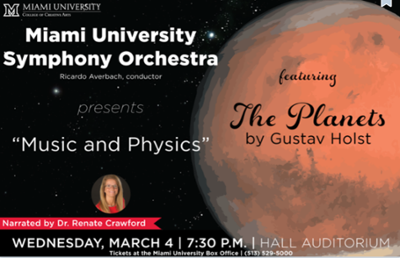Miami's symphony pairs science and music to perform 'The Planets'

Written by Allison Haeger, CAS communications intern

The relationship between physics and music may be seemingly nonexistent to some people. However, the unique partnership between the Department of Physics and the Department of Music for the March 4 orchestra concert of The Planets by Gustav Holst demonstrated that the two fields are much more intertwined than most would expect.
Held in Hall Auditorium, the concert was performed by the Miami University Symphony Orchestra with narration by Dr. Renate Crawford. Each of the planets featured in the musical pieces were narrated with concepts covering the evolution of physics, along with images and quotes from noted physicist Michio Kaku projected on the side of the auditorium.
A combination of strings, woodwinds, brass, and drums, conducted by Miami music director Ricardo Averbach, worked together to transport the audience through 6 out of the 7 movements in Holst's The Planets. Through these pieces, music was used to communicate the personalities each planet embodies through their astrological character, juxtaposed with their actual astronomical role within the solar system.
"When Holst was writing The Planets, he was on an astrology trip, and as a result The Planets was all about astrological ideas," said Herbert Jaeger, professor and chair of physics and author of the narration. "It was our intention to counterbalance this with the astronomical facts, and so we brought physics into the equation."
In the first movement, Mars was labeled the bringer of war, which was shown through the major chord and dissonant stingers of the piece. In between movements, Dr. Crawford drew correlations between the expressionism of the music and the history of physics going back 2600 years to ancient Greece.
"The same harmony that regulates music created by man has origin in the alignment of the heavenly bodies," said Dr. Crawford when introducing the movement for Mercury, "and musical consonance is related with the angular velocities of the planets."
Sophomore strategic communication and linguistics double major, Sarah Pohlman-Beshuk, said she had always wanted to see The Planets. "I loved the concert. I really enjoyed it," she said. "I thought the correlation [between physics and music] was a unique perspective and was portrayed well through the narration."
Kayel Pugazhenthi, a sophomore majoring in interior design, thought the astrological personality of each planet showed through the different movements. "Having each planet have its own feel to it made sense with physics, and I love the way they express the planets," she said. "I love orchestra concerts and would definitely attend more."
"I have never been to an orchestra concert before, and I was mesmerized," said sophomore psychology major Hannah O'Rear, noting that she found the relation to physics throughout the performance added even more dimension to the art presented through the orchestra's music.
Collaboration of the two departments for this event turned out to be a success, as the audience gave a standing ovation for the symphony orchestra, music director Averbach, and Drs. Crawford and Jaeger.

